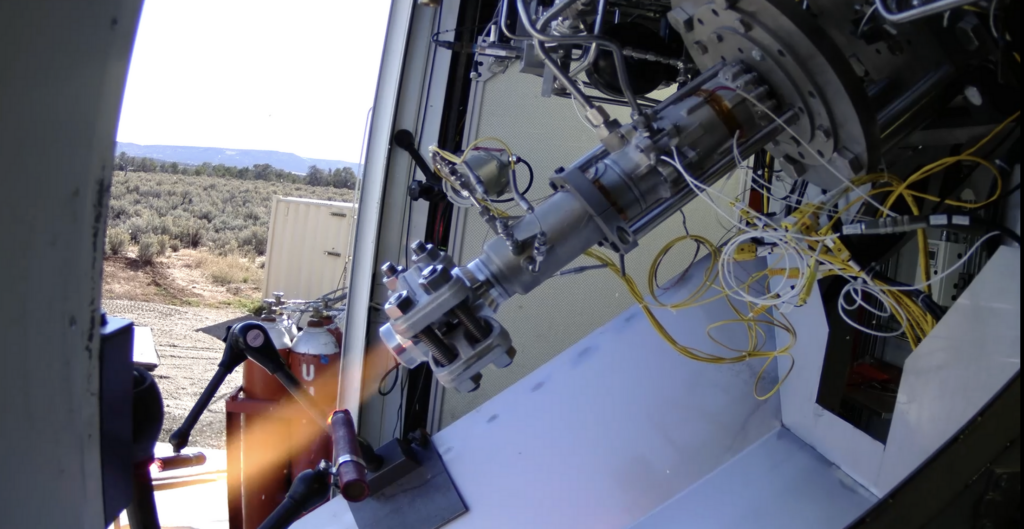In one of the latest developments in the private space industry, Sierra Space, in collaboration with Agile Space Industries, has created the largest ever in-space bi-prop hydrazine engine, the VRM5500-H. A pivotal aspect of this project is the extensive application of 3D printing technology in its construction. Notably, both the AX19 preburner and the thrust chamber, which are critical components of this engine, have been entirely constructed using 3D printing.
Agile’s role in this collaboration included designing, developing, manufacturing, testing, and delivering the AX19 preburner for Sierra Space’s VRM5500-H engine, all within 19 weeks. This rapid development emphasizes the impact 3D printing can have on space engineering. Moreover, the preburner’s design ensures high combustion efficiency and stability across a wide throttle range. It underwent multiple hot-fire demonstrations in a standalone configuration before the team integrated it with the rest of the engine.
Hydrazine, a monopropellant used in the AX19, combusts without an oxidizer, posing a unique design challenge for creating a fuel-rich preburner. Unlike kerosene, methane, or hydrogen engines, partial combustion isn’t possible with hydrazine. Typically, monopropellant combustion requires a large amount of specialized catalyst to remain stable, a costly and resource-intensive process. The company explains that its engineers ingeniously designed the AX19 to minimize catalyst use while maintaining stable combustion. It starts by decomposing a fraction of the hydrazine in a catalyst reactor, producing a hot mix of ammonia, nitrogen, and hydrogen for the main combustion chamber. Then, the system fully combusts the remaining hydrazine and a small amount of oxidizer in the chamber. This innovative approach allows for efficient thermal decomposition of hydrazine, enhancing the preburner’s performance.
Commenting on the latest feat, Agile Space Industries CEO Chris Pearson said “The timeline was extremely fast, especially given that this is the first time that we have been able to find, in the public record, that a high-flow hydrazine-rich preburner has been developed and used in an engine. The initial prototype demonstrated stable operation across a 6:1 throttle range with high combustion efficiency.”
Testing and implications
Following the development of the preburner, it underwent successful standalone testing in October 2022 at Agile’s Animas test stand in Durango, Colorado. Following these tests, Agile Space delivered the preburner to Sierra Space for further evaluation. Then, in 2023, the VRM5500-H engine was tested at the U.S. Army DEVCOM (Combat Capabilities Development Command) stand at Redstone Arsenal in Huntsville, Alabama.
Sierra Space said its new 5,500 lbf hypergolic rocket engine exhibited efficient, stable combustion at all throttle points, confirming its readiness for various in-space applications. Meanwhile, the AX19 preburner operated successfully as a standalone unit and with the full VRM-5500H engine during the first and second quarters of 2023. These tests, covering the entire throttle range, confirmed the stable operation of the preburner and the effective functioning of the VRM5500-H engine.
Promising to be a groundbreaking addition to the company’s portfolio, the engine uses pure hydrazine fuel and MON-3 oxidizer, a type of nitrogen-rich oxidizer, in a staged combustion process. This means it burns the fuel in steps, first in the preburner to generate power for the engine and then in the main part of the engine to create thrust. This efficient way of burning fuel gives the engine a high performance, with a vacuum-specific impulse of over 339 seconds, indicated the company. This specific impulse number is important because it tells us how effectively the engine uses its fuel in space, where saving fuel is crucial. Engineers also designed it for continuous throttling, ranging from 5,500 lbf of thrust at full power down to 900 lbf, enabling precise control and maneuverability.
“This high-performance, re-usable bipropellant engine represents a major leap in space propulsion technology, setting new standards for efficiency, reusability and versatility,” said Tom Vice, CEO of Sierra Space. “This engine is tailored for in-space applications where reusability, storability, throttling and vehicle weight-saving are paramount, making it an excellent choice for landers, upper stages, transit vehicles and extended-duration missions.”
Propulsion leap
The collaboration between Sierra Space and Agile, utilizing rapid design-to-test cycles and advanced additive manufacturing techniques, led to the execution of the engine’s design and testing in just over nine months. This effort marks one of the first instances, as far as public records show, where developers have created and used a hydrazine-rich preburner in an engine.
A significant highlight of the VRM5500-H engine’s development is the extensive use of 3D printing technology. Agile confirmed to 3DPrint.com that it constructed most of the AX19 preburner using 3D printing. Furthermore, Sierra Space has revealed that they built both the thrust chamber and the preburner of the engine using common metallic 3D printers.
This significant use of 3D printing not only demonstrates the capabilities of current manufacturing technologies but also highlights the potential for further innovation in the design and production of space propulsion systems. The success of the AX19 preburner could pave the way for more efficient, cost-effective, and quickly developed components in future space missions, stressing the transformative potential of 3D printing in space technology.
